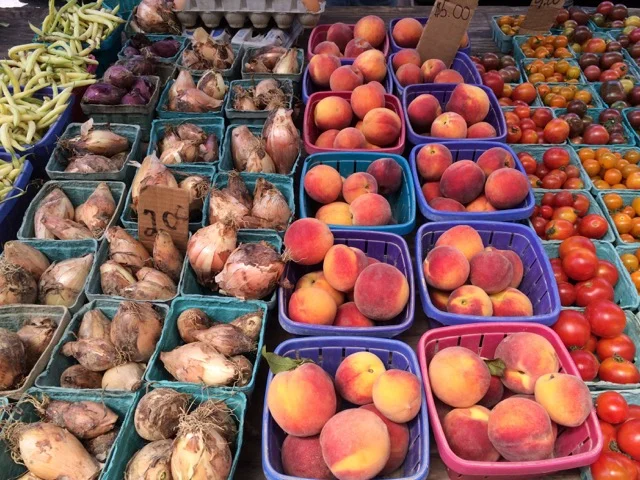This past spring I took the Green Umbrella pledge to shift 10% of my food budget to buying local food. And then I wondered, “What have I done?” I had no idea what my food budget was or what it would entail to fulfill the pledge I was making. Now you may be someone who tracks your weekly spending closely, but I definitely do not, and the prospect of figuring out 10% of my budget felt overwhelming. At the same time, I also needed to select a “Personal Life Change” for a class in my master’s program called Issues in Cincinnati Conservation. This assignment required making a change in my lifestyle and determining the associated ecological benefits. The Green Umbrella 10% Shift Pledge was a perfect fit for this project. I would overcome my budget-tracking resistance and turn this into a learning experience to share with others.
First step: analyzing my food budget. This actually turned out to be simpler than I expected. To get a baseline, I kept all store receipts and tracked which foods were local and which were not for two weeks. This record keeping took a few extra moments after I put my groceries away. At the end of the two weeks I added up the amount I spent on local foods and the amount I spent on non-local foods. Then I figured out what percent of my total food budget was spent on local items. You could do this by entering the amounts in an Excel spreadsheet or just writing two columns on a piece of paper and using a calculator; it doesn’t have to be complicated. And,(drumroll please!) it turned out that 22% of my food budget was spent on local food. What a relief! I already met the 10% shift pledge!
Given my 22% local food baseline, I decided to take the pledge further. If I shifted an additional 10% of my food budget to local food, relative to my current budget, I could set a new goal of 32% local food, and still use this pledge for my school assignment. Which brings us to weeks three and four. For this stage I changed my shopping habits to intentionally increase the amount of local food I purchased. I followed the same process of saving receipts and marking local and non-local items when I got home from the store. Then I added up the columns and found I had increased the percentage I spent on local food to 59% of my budget! Yippee!
Whether you are starting at zero or increasing the percentage in your current food budget, here are some tips on how to reach your local food goal:
Tip #1:
Ask the manager at your regular grocery store to give you a tour of local food items they sell. Ask them to mark these items for other customers as well so that everyone knows. If they find it hard to locate items to show you, mention that you are a regular shopper who would appreciate more locally-sourced options.
Tip #2:
Find a farmers’ market near you by searching the CORV Local Food Locator Map. Add the market’s days of operation to your calendar. Note whether they pause in the winter months or move to an indoor location. There is a farmers’ market within a five-mile drive of my house on every day of the week except Tuesday and Friday. By putting them on my calendar I was reminded to make a trip to the market that day if I needed groceries.
Tip #3:
Buy a share in a Community Supported Agriculture (CSA) program. Not only does this set you up to meet the 10% Shift Pledge, you’ll get a basket of delicious locally-grown produce every week and support a small farm in your community. Find a CSA .
Tip #4:
Replace some non-local food items you normally buy with local versions. This is easy to do with vegetables in the summer, but year round you can buy local bread, eggs, meats and dairy products. Many small business entrepreneurs are making delicious local packaged foods including snack chips, granola, desserts, fermented veggies and other preserved products like pickles, jams and fruit butters. Look for them at specialty stores, farmers’ markets and ask your grocer to stock them. Specialty stores include: Madison’s Market, Clifton Natural Foods, etc.
Tip #5:
Try new foods. Whether it is a kohlrabi bulb that comes in your CSA or a jar of kimchee made by a local company, trying new foods can be fun. You might even find some new favorites!
Tip #6:
Forego some non-local foods. Perhaps they are not the healthiest choices and you have wanted to move away from them anyway. Maybe they are transported an extra-long distance to get to your grocery and therefore have an extra-large carbon footprint. Be sure to check the label for where the food comes from, and note that this is different from where the distributing company is located. Embrace eating local foods when they are in season and find out how much better they taste than their non-local counterparts flown from distant lands.
But what do you do if this is too much for your busy lifestyle? If you just don’t have time to track your budget, the Green Umbrella website states if an average family shifts just $12 per week to local food it can meet the 10% shift goal. And, if just 10% of people in Greater Cincinnati shift 10% of their food budget to local food it will result in $52,000,000 infused into the local economy!
Whew! I was able to fulfill the 10% Shift Pledge and it wasn’t that hard after all. These tips helped me meet my goal while improving the quality of my family’s diet, introducing us to new flavors and supporting the local economy. I enjoyed becoming more aware of my food budget and becoming more connected to the people that produce my food. This shift supports my vision of working toward large-scale systemic change in our food production system while I make a small change in my everyday shopping habits. Will you join me in taking The Pledge? Click here to fill out the online form







